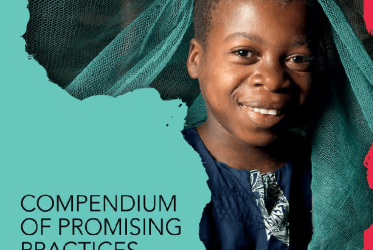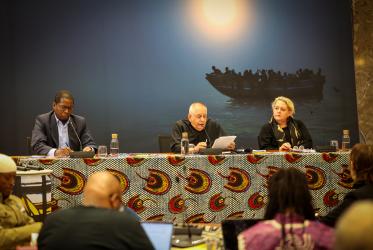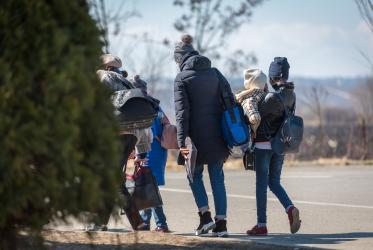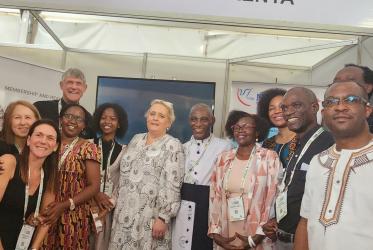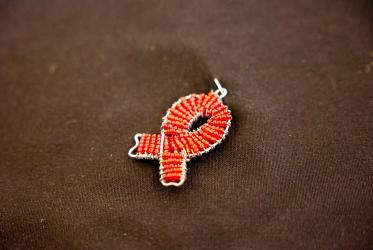WCC-EAA booklaunch 10 March 2016
Dr Gillian Paterson
It’s an honour to be here, and have the privilege of presenting this book – which I saw myself for the first time last night – and it looks fabulous. I want you to know that it’s entirely accidental that I, too, am wearing black and red tonight. My mother, who was a great believer in colour coordination, would have been proud of me!
More importantly – to all of you, WELCOME TO THE CONVERSATION. Because that, in essence, is what this book has been: a conversation that’s been going on for five years now, since 2011. You may think the 23 writers who appear in these pages are a lot, but I promise you they are a fraction of the hundred-plus who have contributed to our discussions
So why this book?
From the moment when AIDS arrived on the scene, there’s been a connection between HIV and human rights. Think of all those stories of people with HIV or their families, who were thrown out of schools or work, killed or evicted: of pregnant women more afraid of a positive diagnosis than of having an HIV+ child: all the results of the stigmatization & mythologizing of this mysterious condition, lurking unseen within the body, somehow transmitted during the very process of generating new life.
Now HIV-related stigma was (is) partly due to fear and to ignorance which, in theory, are curable. In some religious and cultural contexts, it’s also due to the association commonly made between sexual transmission and sin, leading to the belief that AIDS itself is a punishment for sin. Not for nothing do the advocacy groups have the slogan: ‘AIDS is a virus and not a moral condition’. Enough to say that where these attitudes go unchallenged, prevention strategies will not be successful. Further, by making criminals of people who are particularly vulnerable to HIV (through commercial sex work, drug use, men having sex with men etc) we’re actively contributing to the spread of the disease by driving it underground and preventing people from seeking treatment. Further accurate data about HIV in prisons is hard to get, but there is every reason to suspect that conditions in prison make inmates particularly vulnerable to HIV.
These are very difficult topics, and also very hard to talk about. But why?
I want to suggest, in this short talk, that there are a number of powerful discourses operating in our conversations about AIDS, each of them supported by excellent and conscientious people. For example, some years ago I was invited to be an external ‘listener’ at an ecumenical conference on AIDS., which took place in Ukraine. On the way back to the airport, the main organizer (a young doctor) asked me what I’d thought of it. Very interesting, I replied, but why were there over 100 men and only 3 women? “In this country,” he said, “AIDS is a disease of men.” “Really?” I answered. “How about the 200 babies born HIV positive? They weren’t born to men were they?” He looked at me in alarm. “You’re going to start talking about human rights,” he said, “and gender. Westerners always do, but they don’t go down well here.”
“Me?” said I. “Talking about rights? No, I’m talking about public health.” “Ah,” he said. “Public health. That’s OK then. Maybe you are right.’
So what is going on here, and what does it say about the way we communicate with each other?
For the sake of this argument, I’m going to suggest that there’s a conservative-oral discourse (the one that emphasises sin), a public health discourse (the one my Ukrainian friend favoured, that emphasises screening, disclosure and the tracing of contacts) and the one that we label as ‘human rights’, which emphasises the intrinsic dignity of every woman, man and child, simply by virtue of the fact that he or she is a human being. It is our failure to translate between these discourses that leads to some of the difficulties we have in communication. Hence, when I was first asked to work on this publication, one of my colleagues remarked, ‘Goodness, I hope you come out alive –!’
Well we knew it was a lion’s den, hornet’s nest or whatever: but we knew that if we were to do this job properly we would need first to understand what was going on and then to hear the different voices with respect. Which means that, if we have succeeded in what we’ve tried to do, YOU WILL NOT AGREE WITH EVERYTHING THAT’S SAID HERE. What you can hope for, though, is that you will gain some understanding of why it is being said.
What we have done, then, is to structure this book in four parts. Part One looks at some cross-cutting issues present in the overall response to this epidemic. Theologian Julie Clague talks about the history, limitations and possibilities of human rights thinking. Sally Smith from UNAIDS describes the challenges she faces in working with a foot in two camps – a UN organization and the world of religion. Suzette Moses Burton of GNP+ speaks about stigma in the context of her own journey as an HIV+ woman. Hendrica Okondo will tell you something herself about the work of YWCA with young women – who all over the world are particularly vulnerable and lacking in human rights. And finally Callie Long has discussed the human rights issues that healthcare services encounter.
But it’s not at the macro level of academia and international organizations that the real struggles take place: it’s at the level of homes and neighbourhoods and churches all over the world. Accordingly, Part TWO (Contextual Struggles) is entirely given over to accounts by 15 women and men whose personal experience of living with HIV (or in contexts where they’re personally affected by it) drove them to decisions that changed their lives. Our Part 2 writers, like the others, come from four continents and a range of Orthodox, Catholic and Protestant backgrounds. We’ve been so moved by their openness and honesty, and by their willingness to share their personal experience with us, and with you – our readers.
In Section Three, we invited three Christian theologians to suggest theological approaches that might prove illuminating. Dr Mike Schuenemeyer (from the Uniting Church of Christ in the USA) analyses the undermining effects of a theological focus on sin. Rev Ijeoma Adjibade (a Nigerian priest working in the UK) reflects on the power of the idea of the ‘imago dei’. From SAfrica, Catholic moral theologian Dr Nontando Hadebe turns to the theology of the Trinity for a rights based model of community.
And finally – Lyn van Rooyen, director of CABSA, has worked with our writers to put together what is already in demand as an invaluable bibliography and resource list.
So where does that leave us? WCC and our partners in UN bodies are committed to a rights-driven agenda. This has been the case for the whole of my conscious life. Most of the nations of the world have signed up to part or all of the UN rights protocol. Human Rights law is complicated, and can be controversial, but it does provide the world with a baseline for holding the nations to account for what they do. Rights based arguments may sometimes be used inappropriately but they have a vital role in advocacy for just and humane treatment.
Nevertheless, that language (not the concept but the language) is not for everyone. The fact remains that not everyone is comfortable with a language of rights, even if what they’re actually doing is entirely in line with a rights based approach – a state of affairs you’ll find a number of times in Part 2 of this book, especially with contributors from Eastern Europe and parts of Africa. Interestingly, we may note that Pope Francis himself is sparing in his use of rights language, much preferring the language of justice and mercy to that of judgement and rights. Perhaps the next stage of this conversation might be to see what happens when we put the stress on the word ‘human’, and what the story of HIV to contribute to an anthropology of humanity would mean for us, in our time. But that’s for another day.
Now the world talks less about HIV today. It shows signs of moving on, as the world does, to other things. But AIDS is not over yet. And AIDS, and the response to HIV have changed us. Our churches have learned so much from their journey with AIDS: not just about rights, but about being in community, and about how religion impacts on health and healing. In Sierra Leone, during the Ebola crisis, it was to church-related community based HIV programmes that people turned for help. Lessons learned from AIDS have proved (are proving) crucial to the overall response to the Zika virus. So watch this space.
And before I sign off, some final thanks. To NORAD and to UNAIDS for their support with this project. To Michael West and his team for being such efficient and understanding editors, in what turned out to be an unexpectedly complex work. To the editorial committee, and to all our writers and contributors. A very special thank you to Sara Speicher, who has believed in this project and kept it alive through all the uncertainties of the last two years. And finally, to Callie Long, my friend and co-editor, for all the crises and midnight skype calls, and times when we thought this book might never happen. Yesterday, Callie sent me this message to pass on, in which I whole-heartedly join her. She says:
“I am quite humbled to have been asked to be part of this publication; to work with the people whose stories make this publication what it is – that is, an incredibly important contribution to the conversation about human rights that must happen in relation to HIV and to the stigma that is so pernicious and so pervasive. My gratitude to the contributors who spoke with such courage and integrity about an issue that remains difficult, decades into the response. Above all, big ‘thank you’ to Sara and the editorial committee for saying ‘this needs to be done; this needs to be said’.“
Thank you!
